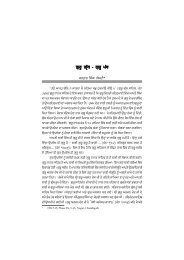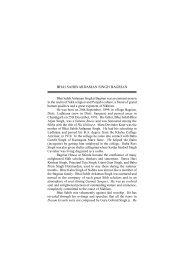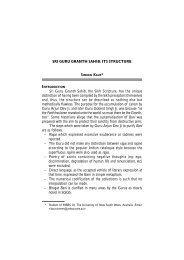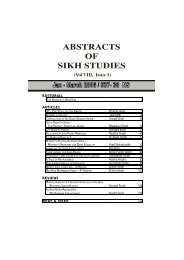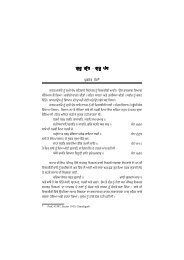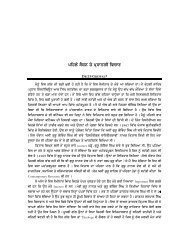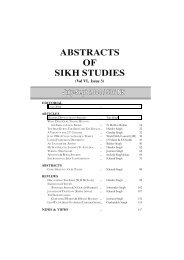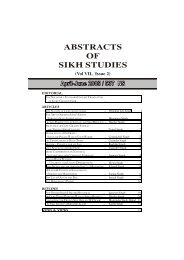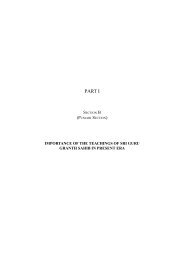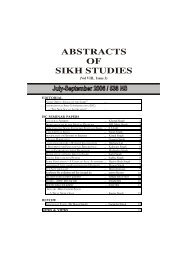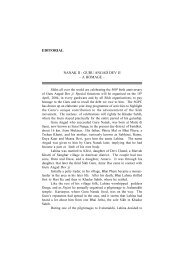Kalaam-e-Goya : Bhai Nand Lal - Institute of Sikh Studies
Kalaam-e-Goya : Bhai Nand Lal - Institute of Sikh Studies
Kalaam-e-Goya : Bhai Nand Lal - Institute of Sikh Studies
Create successful ePaper yourself
Turn your PDF publications into a flip-book with our unique Google optimized e-Paper software.
<strong>of</strong> Deputy Governor <strong>of</strong> the Province.<br />
There, he was married to a girl belonging to <strong>Sikh</strong> religion. he<br />
was very much impressed by the thoughts and the spiritual values depicted<br />
in the verses in Guru Granth Sahib rendered by his wife.<br />
In 1682AD he came on a pilgrimage to Amritsar and from there<br />
he decided to proceed to Anandpur Sahib to seek celestial enlightenment<br />
at the portal <strong>of</strong> Guru Gobind Singh, the Tenth Master. Aurangzeb had<br />
issued strict orders banning all activities pertaining to art and music. It is<br />
assumed that <strong>Bhai</strong> <strong>Nand</strong> <strong>Lal</strong> moved to Anandpur to escape the<br />
Emperor’s wrath against the literary endeavour in general.<br />
Although <strong>Bhai</strong> Jee did create exquisite poetry, yet he did not<br />
gain much prominence. A diamond remains obscured, covered in the<br />
dust till it is captured by the vision <strong>of</strong> a shrewd assayer. When he<br />
presented himself at the Celestial and Temporal Court <strong>of</strong> Guru Gobind<br />
Singh, he tendered and recited his epic poem Bandgi Nama, An Ode to<br />
Worship. It overwhelmed Guru Jee aesthetically and he wrote a couplet<br />
at the back <strong>of</strong> the book,<br />
‘Whose cup is filled with nectarous aqua,<br />
‘He gets the epistle <strong>of</strong> life revealed to him.’<br />
And the name Zindgi Nama, The Epistle <strong>of</strong> Life, was assigned to<br />
the book.<br />
He did not stay at Anandpur Sahib for a long time. It is said that on<br />
the recommendation <strong>of</strong> Guru Jee, in about 1678AD, he joined the cerebral<br />
faculty <strong>of</strong> Prince Muazzam (later Emperor Bahadur Shah) and accompanied<br />
him to the South as his principal secretary.<br />
Emperor Aurangzeb once asked the exposition <strong>of</strong> a certain Ayat<br />
(Couplet) from the Holy Quran. Various Mohammedan priests<br />
expounded it but the Emperor was not convinced. The interpretation<br />
presented by the Prince seemed very authentic and, on enquiry, the<br />
Emperor learnt that <strong>Bhai</strong> <strong>Nand</strong> <strong>Lal</strong>, a Hindu, had explicated it. he<br />
commented why such a learned and intelligent person had not come in<br />
the folds <strong>of</strong> Islam as yet. Suspecting Aurangzeb’s motive, he escaped<br />
and came back to Anandpur after about one year. (This could be one<br />
<strong>of</strong> the points <strong>of</strong> Aurangzeb’s vengeance on Guru Jee).<br />
Although Guru Jee wanted <strong>Bhai</strong> <strong>Nand</strong> <strong>Lal</strong> to stay there just<br />
contemplating on his literary works, his humility led him to spend most <strong>of</strong> his<br />
time serving in the Langar, the community kitchen.<br />
He was at Anandpur up to 1705AD when, under the deceitful<br />
promises <strong>of</strong> the Mughal forces, Guru Jee had to abandon the place. In<br />
the melee that followed, the whole family was scattered. Nothing much<br />
is known about his whereabouts till the death <strong>of</strong> Emperor Aurangzeb. It<br />
appears that he rejoined his previous master, Prince Muazzam, who<br />
had crowned himself as the Emperor under the name <strong>of</strong> Bahadur Shah.<br />
It is said that <strong>Bhai</strong> <strong>Nand</strong> <strong>Lal</strong> was instrumental in persuading Mata Sundri<br />
and Mata Sahib Deva to move to Delhi after the upheaval <strong>of</strong> Anandpur<br />
Sahib. They stayed there till the last days <strong>of</strong> their lives.<br />
Hari Ram Gupta (History <strong>of</strong> the <strong>Sikh</strong>s) maintains that <strong>Bhai</strong> <strong>Nand</strong><br />
<strong>Lal</strong> was present at the Emperor’s Lohgarh campaign against Banda<br />
Bahadur in 1710. When Bahadur Shah died in 1712 he accompanied<br />
his son Jahandar Shah and came to Delhi. Farukh Siyar assassinated<br />
Jahandar Shah in 1713AD. <strong>Bhai</strong> <strong>Nand</strong> <strong>Lal</strong>, somehow, escaped the<br />
rage <strong>of</strong> Farukh Siyar and went to Multan. ‘There he opened a school to<br />
impart higher education in Persian and Arabic. he died in 1718AD*. In<br />
1849, on Punjab’s annexation, the British found this school functioning<br />
under the patronage <strong>of</strong> <strong>Nand</strong> <strong>Lal</strong>’s descendants.’<br />
*According to <strong>Bhai</strong> Kahan Singh Nabha - 1705AD and Dr. Ganda<br />
Singh - 1713AD



